Click on images to enlarge

infestation in a crop (Photo: Steve Adkins)
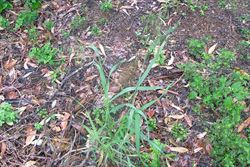
habit (Photo: Sheldon Navie)
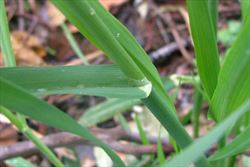
close-up of stem and base of leaf blades (Photo: Sheldon Navie)

young seed-heads (Photo: Steve Adkins)
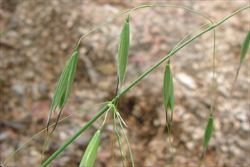
close-up of young flower spikelets (Photo: Sheldon Navie)
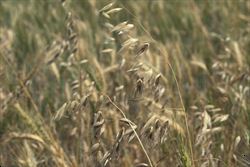
mature seed-heads (Photo: Steve Adkins)
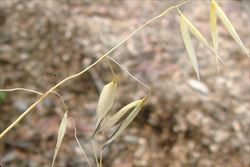
close-up of mature flower spikelets, with large papery persistent glumes (Photo: Sheldon Navie)

seeds with twisted awns (Photo: Sheldon Navie)

close-up of seeds with awns removed (Photo: Steve Hurst at USDA PLANTS Database)

infestation growing in a garden near Beaudesert (Photo: Sheldon Navie)
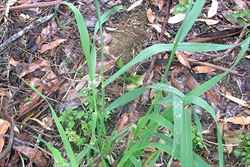
leaves (Photo: Sheldon Navie)
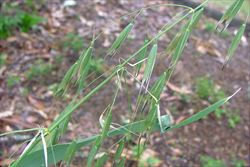
drooping flower spikelets (Photo: Sheldon Navie)
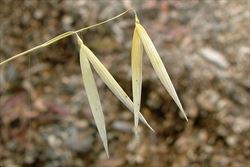
close-up of persistent papery glumes (Photo: Sheldon Navie)

hairy 'seeds' with twisted awns (Photo: Julia Scher)
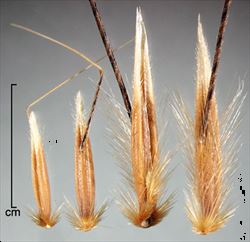
close-up of 'seeds', without bristles at their tips (Photo: Julia Scher)

close-up of the hairy seeds, after being removed from the enclosing flower parts (Photo: Julia Scher)
Scientific Name
Avena fatua L.
Family
Gramineae (South Australia)Poaceae (Queensland, New South Wales, the ACT, Victoria, Tasmania, Western Australia and the Northern Territory)
Common Names
black oat, common wild oat, flax grass, oat grass, spring wild oat, wheat oats, wild oat, wild oats
Origin
The exact native range of this species is obscure, but it is thought to be native to northern Africa (i.e. Algeria, Egypt and Ethiopia), Europe (i.e. Denmark, Norway, Sweden, UK, Austria, Belgium, Czechoslovakia, Germany, Hungary, the Netherlands, Poland, Switzerland, France, Portugal, Spain, Italy, Bulgaria, Yugoslavia, Romania, Belarus, Estonia, Latvia, Lithuania, Moldova, western Russia and Ukraine), the Arabian Peninsula (i.e. Saudi Arabia), western Asia (i.e. Afghanistan, Iran, Iraq, Lebanon, Turkey, Armenia, Azerbaijan, Georgia, Kazakhstan, Kyrgyzstan, Tajikistan, Turkmenistan, Uzbekistan), temperate Asia (i.e. eastern Russia, China, Japan and Korea) and the Indian Sub-continent (i.e. India, Nepal and Pakistan).
Naturalised Distribution
This species is very widely naturalised in southern and eastern Australia. It is most common in temperate regions (i.e. throughout New South Wales, Victoria, Tasmania, the ACT, southern South Australia and the south-western and western parts of Western Australia) and is also present in semi-arid and sub-tropical regions (i.e. in the northern parts of South Australia, the southern parts of the Northern Territory and the southern parts of Queensland). Also naturalised on Norfolk Island and in many other parts of the world.
Notes
Wild oat (Avena fatua) is a very important agricultural weed, and is particularly troublesome in cereal crops. It is also a common weed of roadsides, railway lines, disturbed sites, waste areas, parks, gardens and disturbed and undisturbed natural habitats (e.g. grasslands, shrublands, open woodlands and along waterways). This species is regarded as an environmental weed in many parts of southern Australia (i.e. New South Wales, Victoria, South Australia and Western Australia) and was recently listed as a priority environmental weed in two Natural Resource Management regions.
Wild oat (Avena fatua) is listed as an environmental weed in the wider Sydney and Blue Mountains region in New South Wales. It is also considered to be a major problem in remnant native grassland regeneration projects in South Australia and is a common weed of wetlands in the southern parts of Western Australia. Invasion by this species is an increasing problem at one of only two sites where the endangered Hughans featherflower (Verticordia hughanii) is known to exist near Dowerin, north-east of Perth. Wild oat (Avena fatua) is also listed as a common environmental weed in the Shepparton Irrigation Region and is thought to be a very serious threat to native vegetation formations in the Goulburn Broken Catchment in northern Victoria.

